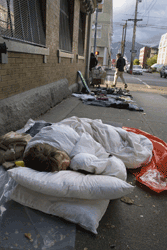
Judy Graves has spent much of the past two years waking the homeless and asking them a simple question: "If I got you on welfare today, and got you a room today, would you move in tonight?"
"They'd say yes," Graves described. "But I could see that what they were really thinking was, 'Bullshit, Lady.' Sometimes they'd say it out loud. They'd say, 'Nobody can do that.'"
Graves, who coordinates the Tenant Assistance Program for the City of Vancouver, was ready to reply.
"Nobody else can do that," she'd tell her newfound client. "But I can do that. And I'm going to show you. So pick up the blanket and tie up the pit bull, 'cause I'm taking you for breakfast."
Graves did show them. In less than two years, she and her small team of outreach workers have ushered more than 700 people from the streets of Vancouver into affordable housing -- not shelters, actual housing.
And she showed Housing Minister Rich Coleman how much could be accomplished by helping the homeless bypass the shelter-to-soup-kitchen shuffle, and proceed directly to the hard work of rebuilding their lives.
As a result of Coleman's support, Graves' move-in-tonight method is now practised by newly hired outreach workers in 28 communities across British Columbia -- and is being studied nationwide.
But Graves told The Tyee that her successful approach will begin to fail this year -- not only in Vancouver but throughout British Columbia -- unless new affordable housing is created.
"There's nowhere left to go," Graves warned. "The SROs are full. The rooming houses are full. The basement suites are full. And with property values rising all through the province, it's not like people can simply move away from Vancouver and find a place to live."
One day, one less homeless person
Graves began at the corner of Bute and Davie, in Vancouver's upscale West End. The number of people camped there had jumped from "two or three" in 2001 to "more than 25" by late 2003, and neighbouring taxpayers were papering city hall with complaints.
"That corner never slept," Graves recalled. "It was like a popcorn maker, between the dealers trying to sell you methamphetamine, people tweaking bumping into you, skateboards grinding past."
Beginning in the fall of 2005, she went to the corner at 6:30 in the morning, woke two people sleeping on the street, and made her astonishing offer: Come with me today, and you'll sleep inside tonight.
"I'd take them for breakfast," Graves explained. "People tend to think that all the appalling behaviour they see on the street is caused by drugs. In fact, much of it is because their blood sugar is unstable. They're hungry and their blood sugar sinks. We come along and give them a doughnut. Their blood sugar soars, then plummets. They're a mess.... I'd start by getting some protein into them, so that they could settle down a little bit. And during that hour we would bond."
After breakfast, Graves walked her new friends (and their belongings) to a nearby office of the Ministry of Employment and Income Assistance, where a sympathetic caseworker was prepared to process their welfare claims. The ministry found ways to issue same-day cheques, despite the fact that many clients lacked legal identification.
While the welfare staff worked such minor miracles, Graves worked her mobile phone in search of housing. Once the welfare paperwork was complete, she'd take her new clients on a tour of whatever accommodations were available that day -- most often a small selection of dingy rooms in downtown SROs. As the day wore on, she'd supply cigarettes to help her clients shave the jagged edge off withdrawal.
Once a room was found and tenancy agreement signed, she and her entourage would return to the welfare office, collect cheques made out to the landlord, then shuttle back to the hotel.
"The landlord gets a cheque. The tenant gets a key. And Vancouver gets one less homeless person," Graves said.
"We had to do the whole thing -- from waking them up on the sidewalk to getting them into a room of their own -- in one day," Graves said. "Because these guys had no patience at all. They were so used to being disappointed, that if you make them wait, to them it means nothing is going to happen."
Rural homelessness rising
Of the more than 700 homeless individuals gathered up by Graves and her team at the city's Housing Centre, 82 percent remain on welfare -- and 77 percent remain housed.
Almost as amazing as those statistics is the fact that the BC Liberal government -- which in 2003 rejected Graves' proposal as "case-finding" and therefore inconsistent with Premier Gordon Campbell's goal to trim welfare rolls -- has since 2005 embraced Grave's housing-in-a-day approach under Housing Minister Rich Coleman.
"When I see somebody who has illiteracy issues and can't even look up in the phone book where a social services office is... I know that we need to help them connect," said Minister Coleman, who represents the Fort Langley-Aldergrove riding.
Working with local health authorities and non-profit agencies, BC Housing has implemented a three-year pilot project modelled directly on Graves' approach. Cities as diverse as Abbotsford, Nanaimo, Prince George, Surrey, and Victoria are among the 20 communities now served by homeless outreach programs.
"We got away from cutting ribbons and started taking care of people," Coleman said.
At the same time, a pilot program launched last summer by the Canadian Mental Health Association (CMHA) is testing Graves' methods in another eight British Columbia communities, including Kamloops, Williams Lake and 100 Mile House.
Both the provincial and federal outreach programs are confirming what small-town shelter operators have been reporting for about a year: rural homelessness is exploding across British Columbia, with collective numbers that could surpass urban homeless populations in the next few years.
The one-year CMHA project, for example, found 800 clients in its first seven months: 70 per cent of those grappled with drug or alcohol addiction, 65 per cent had mental health-related challenges, and 44 per cent had a physical health issue.
"When we started this project, we thought of it in more of an urban context," said Teya Greenberg, who coordinates the one-year pilot project from CMHC's Vancouver office. "There's no one sleeping on the streets in small towns. But that doesn't mean there are no homeless people."
Housing First proven effective
"Housing provided the safety and security that made it possible for people to begin to reduce their substance use. Housing also provided a base for the residents to form friendships, get to know themselves, develop and establish their own networks, and become connected to the community."
Those are the findings of a 298-page report released by the Canada Mortgage and Housing Corporation in July 2005. In search of objective information about which strategies were most effective at helping homeless people with addictions, the federal research team surveyed academic reports and examined 13 homeless-oriented projects in the U.S., U.K. and Canada.
What they found was that most of the rest of the world had already arrived at conclusions similar to those reached by Graves back in 2003: "When asked what they thought were the most effective services they provided, almost all the agency key informants identified housing."
A type of social housing called "supportive housing" is particularly favoured by research. Supportive housing is affordable housing with on-site staff available to help tenants stabilize their lives, enhance living skills, and re-connect with community. These "supports" vary from general-purpose counsellors who visit during office hours to medical staff who prepare meals and care for client needs around the clock. Most fall somewhere in between.
Supportive housing is nothing new to Canada. The Vancouver Coastal Health Authority, for example, has operated supportive housing for decades, and currently maintains about 1,200 units in 37 buildings. Its own studies show that tenants living in supportive housing achieve abstinence sooner, stay clean longer, and return to mainstream populations in higher numbers than do tenants housed in unsupervised rooming houses or SROs.
Likewise, U.S. authorities have largely abandoned as ineffective the law-and-order approaches such as the Civil City plan being launched by Vancouver Mayor Sam Sullivan. Even U.S. President George W. Bush's hand-picked Homeless Czar now advocates providing housing before requiring abstinence, an approach the Americans call "Housing First."
No room at the inn
Vancouver's homeless approach was recently awarded the Premier's Award for Service Excellence. But the creator of the outreach component, Judy Graves, warned that the housing-in-a-day program will soon fail unless additional affordable housing is identified.
"Even the residential hotels in the downtown Eastside, which were the very last place that anybody would want to live, are now basically at zero vacancy rate," Graves said. "Anybody who's in the street now is going to have a hard time."
The shortage is more severe beyond Vancouver.
"The housing situation has reached a critical point," said Greenberg, of the CMHC. "Even in 100 Mile House, there is no vacancy."
"There is practically no housing that is affordable at shelter allowance rates. The vacancy rates are so low in most communities, that it is extremely difficult to find units even at higher rents."
Minister Coleman has expanded BC Housing's response to homelessness more strategically than any minister in memory. He's put 2,000 families at-risk of homelessness on rent assistance, and aims to help thousands more before they lose their homes. He's converted hundreds of seasonal shelter beds to year-round units. He's funded homeless outreach projects across the province. And he's reached the same conclusion as Graves and Greenberg.
"As we came through that cycle," Coleman said, "it became very clear that we were going to have success with the outreach programs -- and that we need more supportive housing."
Related Tyee stories:
- Seven Solutions to Homelessness
Each is working somewhere else, and will save money and lives here. - Province Snaps up Poverty Hotels
Plan to protect housing catches insiders off guard. - Shovelling with Mayor Sam
Stalled homeless units finally jarred loose. Pols scramble for credit.

















Tyee Commenting Guidelines
Comments that violate guidelines risk being deleted, and violations may result in a temporary or permanent user ban. Maintain the spirit of good conversation to stay in the discussion.
*Please note The Tyee is not a forum for spreading misinformation about COVID-19, denying its existence or minimizing its risk to public health.
Do:
Do not: